
PRESERVATION SNAPSHOT
This monthly feature highlights recent and fascinating National Register listings and eligible properties, tax act projects, compliance review success stories, as well as outstanding local efforts in New Jerseys historic preservation.
Harleigh Cemetery and its Famous "Residents"
Camden, NJ

Nothing spooky here; move along. It may be October, the
season of ghosts and goblins, but Harleigh Cemetery in Camden, New Jersey is not the typical old graveyard of lore. On the contrary, Harleigh was built as a landscape lawn cemetery when it was laid out in 1885 part of the popular Rural Cemetery Movement of the late 19th century that believed cemeteries should be like public parks, designed and promoted as spaces for leisurely walks, picnics and family gatherings.
Landscapes were "not for the dead, they are for the living." - Henry Bellows
Harleigh Cemetery does, however, boast a long list of impressive people who have chosen it as their final resting place. Topping the list is New Jersey poet, Walt Whitman. Others include members of some of the area's leading
families businessmen, doctors, politicians and military leaders.
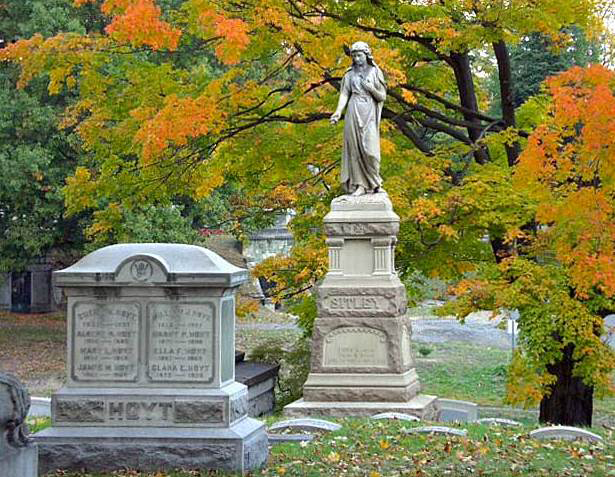
Unique Design
With 150 acres and over 48,000 interments and entombments, the 130 year-old cemetery remains one of the most picturesque areas of the city. Built on the former estate of Isaac Cooper, the grounds were laid out in circular drives with pleasing names such as Shady Linden, Forest Dale and Magnolia. Visitors wound their way past open lawns, man-made lakes, gardens and diversified plantings. In addition, early cemetery regulations prohibited any duplication of monuments, resulting in a fascinating variety of marble or granite markers and statuary sculpture that are unique to the people who are memorialized.
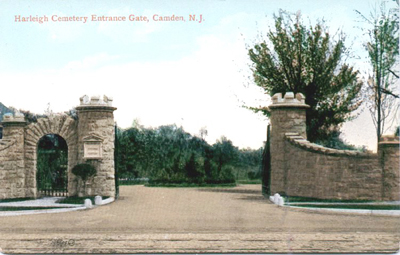
No plans identifying the original cemetery designer have been located, but a pre-1890 rendering of the cemetery illustrates the design was part of the initial concept. An 1886 public vault, intended to hold caskets until the spring thaw facilitated interment, was built into the bank overlooking the lake, as were several private vaults. By 1893, three new lawns were laid out (Mt. Hope, Haddon and Spring Grove) and 700 people had been interred. In 1902, local Camden architect, Thomas Stephen designed and installed the handsome granite and wrought iron entrance gates on Haddon Avenue. By 1920, the cemetery association had acquired additional property to the east. The character of the eastern section is markedly different from the older western portion, however, with little or no landscape treatment. While plans reveal this area was intended for treatment, the plans were never implemented.

Funerary Sculpture
The unique and diverse funerary sculpture and monuments in Harleigh Cemetery span an intriguing spectrum of styles, subjects and craftsmanship. Created mainly in the late-19th and early-20th century, they spread throughout the 22 lawn areas, and encompass five public mausoleums and 21 private mausoleums and vaults. Highlights include:
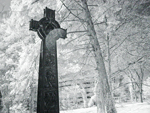
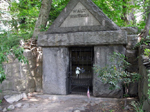
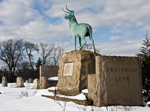
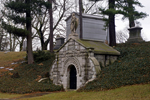
- Celtic Cross designed by artist,
Alexander Stirling Calder in 1901 for the
General William Joyce Sewell (US Senator) grave, stands 20' high and six feet wide. One of only two crosses attributed to Calder, the cross bears his signature and date of completion. Flanking flat graves on either side of the cross, also designed by Calder, are those of Sewell's wife and daughter. - Walt Whitman tomb designed by the poet himself.
- Bronze, life-size elk statue (sculptor unknown) commissioned for "Elks' Rest" the 1915 burial plot of the Camden Elks Lodge #293 BPOE, accommodating 100 deceased Elks' members.
- "Garden of Dreams" (aka "Garden of Memories")
gravesite of Dr. Wilson Gill Bailey which includes a Classical Revival style mausoleum containing a bronze bust of the doctor, and archway, sundial, memorial benches, urns and platforms leading from one element to another, executed by
O.J. Hammel Company of Camden. - Nine other mausoleums designed in the classical revival style.
- Unusual holding vault of serpentine stone erected in 1885.
- Eleven other family vaults built into the hillsides overlooking Magnolia and Asorocules Circle Lakes.
- Harleigh Memorial public mausoleum built in 1928-30 of monumental granite and marble, designed by Lovell and Lovell (Chicago, Illinois) in the Classical Revival style. The front faηade is 160' long; interior walls, floors and crypts are of white marble; two chapels contain stained glass ceilings. There are 29 bronze gates decorated with a fretwork of leaves and urns, each leading to a family crypt.
Above:
Celtic Cross by Calder; Photo credit: Lisa Campeau
Walt Whitman Tomb; Photo courtesy of waymarking.com
Elks' Rest Plot; Photo courtesy of flicker.com
Harleigh Cemetery private vault; Photo courtesy of flicker.com
Walt Whitman as Lure
The landscape architecture of Harleigh Cemetery clearly borrows from the plans of several of its predecessors Mt. Auburn Cemetery in Cambridge, Massachusetts, and Laurel Hill Cemetery in Philadelphia, Pennsylvania. Like these two earlier rural cemeteries (and their model, Pere-LaChaise in Paris, France) a prominent person was offered a free lot in order to attract other buyers. At Harleigh, that person was local poet and essayist, Walt Whitman. The publicity worked. After Whitman made his funeral arrangements to be buried here, business in this working class neighborhood's cemetery increased dramatically.
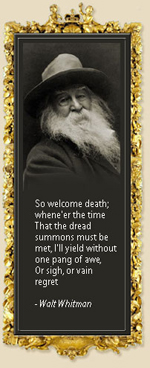
Whitman (1819-1892) enthusiastically embraced the idea, and designed his tomb himself. His sketch and handwritten notations appear in his collected correspondences. Whitman personally selected the site of the tomb on Christmas Day, 1890; one year after being offered a lot as a gift from the new Cemetery association.
A friend writes "I was once taken for a ride in Whitman's carriage. Walt said, 'Where should we go?' I had no preference. He then said, 'You have not been to the tomb!' and he called out, 'Same place, Warry' as though the tomb were his common resort. We drove through Camden, out to the green fields and finally to Harleigh Cemetery in which Walt had been building the massive granite mausoleum where he and his parents were to be interred. We drew up in a deep dell where the tomb was built into a hillside, and Walt told me to get out and look inside. The door was open. It was like a structure of the Druids and he said he had himself planned it. It united Blake and Ossian in its design.
I looked at the triangular pediment and I was startled to see carved in it the words, 'Walt Whitman May 31, 1890.' It had the appearance of being already occupied. It was explained that the cemetery people had with characteristic grim taste somehow got the idea that the tomb was presented to Walt by his friends at the last birthday party and they had introduced the date of his birthday in the place where should have stood the date of his decease. This was, of course, afterwards corrected."
— Harrison S. Morris, Whitman's friend
Placed into a hillside, there are only three granite sides to the tomb, each 18" thick. It is held together by the interlocking granite there are no rods or bolts to grip the immense pieces in place. Some stones are calculated to weigh as much as ten tons. The front of the structure alone, estimated at 70 tons, anchors the entire tomb to the ground without movement. The door of the vault weighs 2200 pounds of 6" thick granite, and swings on brass pivots.
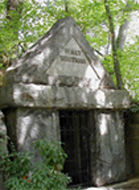
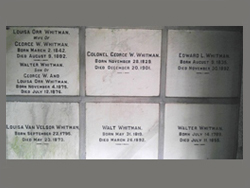
Right: Walt Whitman Tomb Interior; Photo courtesy of dinnerwithwalt.com
There are eight crypts in the vault, containing the remains of members
of Whitman's family. In addition to Walt Whitman, are his mother,
Louisa van Velsor Whitman; father, Walter Whitman; brothers, George
and Edward Whitman; sister, Hannah Whitman Hyde; and George's wife,
Louisa Whitman.
The vault lies in close proximity to Whitman's house (a National Historic Landmark), as well as the Walt Whitman International Poetry Center in Camden. No other tombs have been erected in the area of Whitman's final resting place.
Bird Sanctuary / Conservation Area
Harleigh Cemetery as a parkland with several manmade lakes, serves as a bird sanctuary and conservation area in an urban environment. An inventory of the birds sighted in the cemetery over several years' time tallied 124 different species, 35 of which were nesting for at least one season.
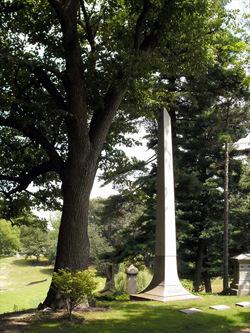
Photo courtesy of waymarking.com
Many species of trees including hardwoods and conifers are found throughout the cemetery, however very few are native species or original to the estate from which the property was originally acquired. Planted in general patterns are Norway Maple, Red Oak, Sycamore, Linden, Balsam Fir, Red Pine, Balsam and Cedar trees. Three significant specimen trees are the Copper Beech in the Terrace section. The only area of the cemetery that maintains a native character is Beechwood, where several American Beech and Overcup Oak of considerable age are found.
National Register
Harleigh Cemetery is eligible for the National Register of Historic Places under Criterion C based on the artistic merit of the cemetery funerary art, architecture and landscape
architecture and its well-preserved late 19th & early 20th century character.
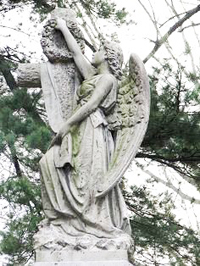
Photo courtesy of pinterest.com
Notable Burials
- David Baird (1839 1927)
US Senator 1918-19 responsible for building up the Merchant Marines, espousing a large navy; political colleague of General William Joyce Sewell; County Sheriff; Camden County Freeholder; Camden County Republican leader; founder of David Baird Lumberyard. - David Baird, Jr. (1881 1955)
US Senator 1929-30. - David Benjamin Bechtel
(1833 1908) Artist whose portrait of a Civil War general hangs in the Union League in Philadelphia, Pennsylvania. - Ella Reeve Omholt Bloor
(1862 1951) Descendent of the abolitionist, Thaddeus Stevens and the Ware family (noted south Jersey cabinetmakers); suffragette, temperance worker, labor union organizer and socialist. She was appointed by President Theodore Roosevelt to investigate the Chicago stockyards' working conditions. She requested burial in Harleigh Cemetery to be near Walt Whitman and his biographer, Horace Traubel. - Charles Shimer Boyer (1869 1936) Camden mill owner, civic leader, benefactor of the Camden County Historical Society, local historian and author.
- William J. Browning (1850 1920) US Congressman 1911-20.
- George C. Burling (1834 1885) Civil War Union Army officer as colonel and commander of the Sixth NJ Volunteer Infantry.
- S. Canning Childs (1859 1932) Collingswood, NJ grocery store magnate, developed one of the first grocery store chains in the US which was later sold to American Stores; philanthropist and benefactor of West Jersey and Cooper hospitals.
- Levi Farnham (1856 1923) Camden City engineer for over 30 years, responsible for Farnham Park, Kaighn Avenue and Baird Boulevard.
- Onan Bowman Gross, MD (1851 1906) Helped establish the NJ State Board of Medical Examiners; descendent of pioneer settlers of Lancaster County, Pennsylvania.
- Carl McIntire (1906 2002) Founder and minster in the Bible Presbyterian Church.
- Sophia Presley, MD (1834 1909) First woman to be elected to the Camden County Medical Society; Camden physician; graduate of Women's Medical College (Philadelphia, Pennsylvania).
- William Joyce Sewell (1835 1901) Civil War General noted for Battle of Chancellorsville; US Senator 1881-87 and 1895-1901.
- John F. Starr (1818 1904) US Senator 1863-67.
- Henry Genet Taylor, MD (1837 1916) Civil War Brigadier Surgeon; Corporator and Secretary of Camden City Dispensary; descendent of Citizen Genet, first French Ambassador to America. His Camden home is listed in the State & National Registers of Historic Places.
- Horace Traubel (1858 1919) Biographer of poet, Walt Whitman.
- Walt Whitman (1819 1892) Great American poet whose tomb attracts thousands of visitors annually.
- Nick Virgilio (1928 1989) Nationally recognized Haiku poet; helped to found the Walt Whitman Arts Center; native of Camden.
- Charles Wolverton (1880 1969) US Congressman 1927-59; Camden County Republican leader; County prosecutor.
Additional Sources: US Department of the Interior, National Register of Historic Places Inventory-Nomination Form, "Harleigh Cemetery"; NJ Office of Historic Preservation Historic Sites Inventory Individual Structure Survey Form, "Walt Whitman Tomb" and "William Joyce Sewell Memorial Cross"; "Birds of Harleigh Cemetery," Jean A. Rodgers; "Harleigh Cemetery, A Study of Natural Landscape," Joan Batory, Director, Camden County Environmental Agency; "Harleigh Cemetery, Camden" Wikipedia.com.
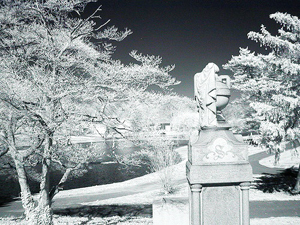
PRESERVATION SNAPSHOT ARCHIVES
- February 2016: Trenton's Pottery Industry
- January 2016: Art Deco & Art Moderne Architecture
- December 2015: Buildings in the Battles of Trenton
- November 2015: Hinchcliffe Stadium
- October 2015: Harleigh Cemetery
- September 2015: Boylan Street School
- August 2015: Catboats
- July 2015: Lucy the Elephant
- June 2015: Mount Tabor Historic District
New Jersey 350
If you enjoy Preservation Snapshot, you may also enjoy:
New Jersey 350 Archives
Forms and Publications:
- Preliminary Application Package:
- New Jersey and National Register Preliminary Application Questionnaire (PDF Format)Preliminary Application Survey Forms (PDF Format)
- The New Jersey and National Registers of Historic Places Fact Sheet (PDF Format)
New Jersey and National Registers of Historic Places vs. Local Designation Fact Sheet (PDF Format)NR Bulletin #15: How to Apply the National Register Criteria for Evaluation (NPS Website)NR Bulletin #16A: Guidelines for Completing National Register Forms (NPS Website)
- New Jersey Register of Historic Places Act (N.J.S.A. 13:1B-15.128 et seq.) (HTML)
Useful Links :
|
|
||
|
||
| |
||